Click here to download the PDF guide! (Also see this post: “FAQs: What Are Safe Cooking Fats & Oils?“)
I get a TON of questions regarding fats and oils. And rightfully so. There is a TON of confusing, conflicting and darn right misleading information out there about which are the healthy ones for us to consume. I tend to come back to my three basic decision-making questions regarding pretty much any food choices and those are:
- Did my great, great grandmother eat this? (Or somebody's great, great grandmother in another country.)
-
How much processing is required for this food to go from the plant or animal to the item I'm about to eat?
-
Does it TASTE good? (Really, if it doesn't taste good, what's the point?)
 One of the reasons people get confused about fats and oils is that there are SO many out there on the grocery store shelves touting different qualities and with labels that hard-sell you on how wonderful they are for different cooking methods. In order to enlighten you on some of the important facts about fats and oils that you should know, I am going to share some excerpts from what I consider to be THE leading resource regarding this topic, Know Your Fats by Mary Enig, Ph. D. According to Dr. Enig: “Fats and oils (technically called lipids) are basically made up of collections of molecules called triglycerides. If the collection is liquid at ambient temperature, it's called an oil; if it is solid, it's called a fat.” Enig also goes on to explain that: “Whether these food lipids are called fats or oils sometimes depends on their ambient temperature where they originate. Palm oil and olive oils are fruit oils, and coconut oil is from a fruit, which is also a seed; they are liquids at the ambient temperature where they are produced.”
One of the reasons people get confused about fats and oils is that there are SO many out there on the grocery store shelves touting different qualities and with labels that hard-sell you on how wonderful they are for different cooking methods. In order to enlighten you on some of the important facts about fats and oils that you should know, I am going to share some excerpts from what I consider to be THE leading resource regarding this topic, Know Your Fats by Mary Enig, Ph. D. According to Dr. Enig: “Fats and oils (technically called lipids) are basically made up of collections of molecules called triglycerides. If the collection is liquid at ambient temperature, it's called an oil; if it is solid, it's called a fat.” Enig also goes on to explain that: “Whether these food lipids are called fats or oils sometimes depends on their ambient temperature where they originate. Palm oil and olive oils are fruit oils, and coconut oil is from a fruit, which is also a seed; they are liquids at the ambient temperature where they are produced.” And that:

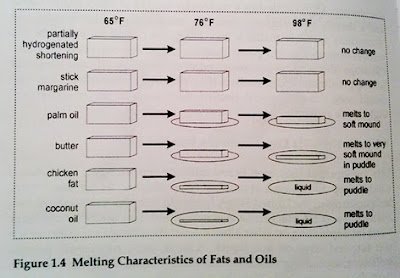 So, that's the primer on fats and oils. Now, when we look at the concept of naturally occurring or minimally processed versions that are the most ideal to consume, this is when the confusion really kicks in. You can imagine how animal fats are “made” since typically you're left with them after cooking meat. For example, you are left with pork fat after you cook bacon and it melts away from the meaty part. The same thing happens when you roast a chicken; liquid from the bird will fall to the bottom of the pan along with fat. You can make butter from cream with just a little elbow grease (pun intended). When you think about just how you get oil from something like a rapeseed (the type of seed used to make canola oil), however, the process is a bit less intuitive. I have already explained why I avoid canola oil specifically in a previous post. It's important to note that MANY unsaturated fats are processed in a similar if not identical way.
So, that's the primer on fats and oils. Now, when we look at the concept of naturally occurring or minimally processed versions that are the most ideal to consume, this is when the confusion really kicks in. You can imagine how animal fats are “made” since typically you're left with them after cooking meat. For example, you are left with pork fat after you cook bacon and it melts away from the meaty part. The same thing happens when you roast a chicken; liquid from the bird will fall to the bottom of the pan along with fat. You can make butter from cream with just a little elbow grease (pun intended). When you think about just how you get oil from something like a rapeseed (the type of seed used to make canola oil), however, the process is a bit less intuitive. I have already explained why I avoid canola oil specifically in a previous post. It's important to note that MANY unsaturated fats are processed in a similar if not identical way.
I'll abbreviate the process of getting oil from seeds here as Dr. Enig recaps it:

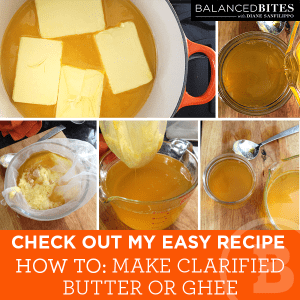 “Fats or oils from some seeds, such as sunflower, are extracted fresh from the seed by grinding of the seeds, followed by expeller pressing with or without a solvent such as hexane. Some seeds require precooking of the seeds before the grinding and the pressing. Rapeseed is such a seed. Mechanical extraction is considered to be a safe method, but because the recovery of oil by this method is less than the industry desires, most oils are extracted using a solvent… In this case, the oils are pressed from the seeds without the use of solvents, and without increased yield. These oils are usually more costly in the marketplace. The steps in commercial processing from the seed to the oil include crushing, extracting (by mechanical means or by use of solvents), degumming, neutralization, dewaxing, bleaching, filtration, and deodorization. Oils are frequently referred to as RBD, which stands for “refined, bleached and deodorized.”
“Fats or oils from some seeds, such as sunflower, are extracted fresh from the seed by grinding of the seeds, followed by expeller pressing with or without a solvent such as hexane. Some seeds require precooking of the seeds before the grinding and the pressing. Rapeseed is such a seed. Mechanical extraction is considered to be a safe method, but because the recovery of oil by this method is less than the industry desires, most oils are extracted using a solvent… In this case, the oils are pressed from the seeds without the use of solvents, and without increased yield. These oils are usually more costly in the marketplace. The steps in commercial processing from the seed to the oil include crushing, extracting (by mechanical means or by use of solvents), degumming, neutralization, dewaxing, bleaching, filtration, and deodorization. Oils are frequently referred to as RBD, which stands for “refined, bleached and deodorized.”

Click here to download the PDF guide! (Also see this post: “FAQs: What Are Safe Cooking Fats & Oils?“)
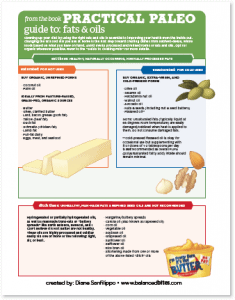
Enjoy & be well! Diane Sanfilippo BS, Certified Nutrition Educator, C.H.E.K. Holistic Lifestyle Coach San Francisco Nutritionist & Paleo Nutritionist serving the Bay Area and beyond via phone & Skype consultations. “Bacon is rad. Gluten is bad.” Sport it on a T-shirt.

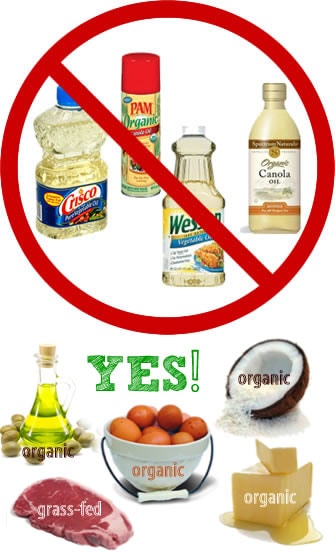
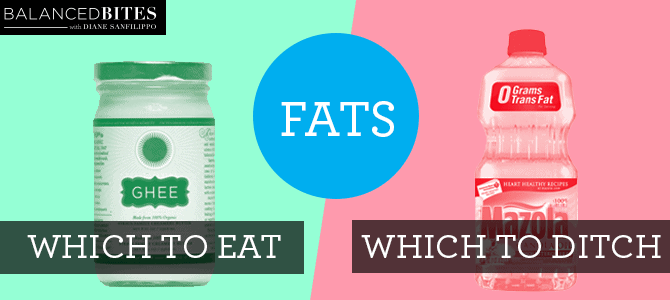
Comments 64
Good stuff Diane!! The world needs to read this, it is so important to understand! Hey have you read the book, 'Fat' by Jennifer McLagan, it looks really good!!
@Lydia- thanks! Actually, a friend of mine JUST gave me that book as a congratulatory gift for finishing my educational program. 🙂 So it's on my pile to read as we speak!
I really enjoy reading your blog- you have been a great resource for me and the nutrition class I teach at Crossfit- so thanks!! Keep up the great stuff!!
Fats are a topic where there is so much confusion based on misinformation, so a handy, simple guide like this is incredibly useful!
Sally
@Sally- thanks! Where are you located? I'd love to hear more about the class you teach. Email me- [email protected]
I actually have a question. If we should be keeping olive oil for non-cooking use, what does this say for putting it on veggies to either roast in the oven, or on the BBQ???? We've been doing this for ages.
New to your blog, but looking forward to delving into it!
Marilyn
Hi Marilyn-
Ideally you don't want to heat olive oil above it's smoke point which is 280 degrees F (according to Mary Enig's "Know Your Fats," p. 146). If you think about how hot your oven gets when you roast (at least 325, but up to around 425 degrees) that's probably too hot. if you're going to very quickly and lightly sauté something in olive oil at a low temperature, it should be okay, but you don't want to see it smoking! Smoking oil means that it's oxidizing which is when the chemical structure begins to change. Oxidized oils lead to inflammation in our bodies, a major factor we're trying to avoid when we talk about staying healthy!
For reference- Palm Oil's smoke point is 451 degrees F and peanut oil is 425 degrees F. People have used canola oil for high heat because of it's high smoke point, but that neglects the entire process that oil went through before being bottled for consumption.
I hope that helps!
Hi,
I love all your recipes. Do you plan on releasing a cookbook?
Monika
@Monika- I do, but not for a while most likely.
Great article on fats, it really "digests" the facts into "bitsize" pieces :] If you don't mind I'm going to print this off and pin it on the wall of my gym, should help to reduce the time I have to try to explain this subject to my guys!
@Darren- feel free to print the article as well as the PDF for people 🙂 Just make sure you leave reference to my website on anything you print/distribute- thanks!!
grapeseed oil? really?
🙁
i was under the impression that it was a safe oil if properly harvested.
@Anonymous (I wish you'd at least use a first name here so I can address you)–
It's largely a matter of production process vs harvesting when it comes to most seed oils. I am not one to simply claim a food is healthy if it's nutrient profile looks decent. I like to think about and consider the PROCESS something has gone through from nature to my plate. A grape seed is tiny and undergoes significant processing to extract it's oil and it's refined. I always recommend cold-pressed, unrefined oils. It's pretty dangerous to consume oils that have become oxidized or rancid (this happens mostly with unsaturated fats), and highly refined oils like canola, soybean and grape seed are easily susceptible to oxidation.
I make these guides based on my education and reading and would only recommend to others what I would consume myself. That's the best I can do! 🙂
Just bought a can of grapeseed oil. Would it help to keep it in the fridge? Thank you for all.
I don’t recommend using it at all.
This is great info thanks. I bought a gallon of red palm oil and do use it for veggies.Any other ideas for its use?
@Sarena- You're welcome… I don't have tons of ideas for it but maybe search for recipes? I'd try basting meat/chicken with it before roasting perhaps.
Thanks for the quick response, I just linked you to my blog as well! Where are you located in SF?
I was referred here after asking about grapeseed oil on another site. I understand, I think, but must say my head is a little spinning. My grocery has 100% Mechanically (Expeller) Pressed Naturally Refined Walnut Oil. It sounds so mixed, is the "naturally" in there to throw me off? I'm sure I want cold-pressed? I'd appreciate the short answer…
thanks,
sarene (not sarena, although isn't that funny…)
This is an old comment but I thought I’d put my two cents in. Walnut oil goes rancid very easily no matter how it was produced. Also it’s just about all omega-6. We already get far too much omega-6 in our diets and no matter where it comes from, it’s a good idea to cut back on it. Walnuts themselves are OK to eat in reasonable amounts (I wouldn’t try using them as a flour substitute, for instance, the way you might with coconut flour–just eat a serving of the whole nuts every now and again), because they’re a good source of minerals, but I’d leave it at that.
Agreed- this is why I made the new post as well about cooking fats…
http://blogbb.wpengine.com/2011/09/faqs-what-are-safe-cooking-fats-oils.html
@Sarena- Russian Hill
@Sarene- I can only answer from the point of view of what I'd use… I don't like the sound of any refined oils. That said, some oils seem to be perfectly fine/healthy to consume as refined such as coconut oil. I have a feeling that refining nut oils is damaging to them. I personally wouldn't use walnut oil as I think it's delicate, unless it was an unrefined, raw oil possibly and then I'd use it only for a cold application, not heated.
Sorry I don't have more information, but I don't really fuss over a lot of different oils personally, so I don't recommend that others do either. I prefer saturated fats mostly.
This is great, thanks! I think you have to be very careful with the nut and seed oils, though, because they can become rancid very easily. You have to keep them away from the air, in the dark, and cool, and throw them out if they are very old, even a few days, sometimes. The exception is sesame oil that has its own preservatives that are released when heated. Also, polyunsaturated oils in general become rancid very easily, and don’t contain cholesterol. I believe cholesterol is an essential nutrient, because many people who don’t consume enough of it become cholesterol deficient, such as myself and several family members that I know of. The exception to polyunsaturated oils being a problem is the wonderful fermented cod liver oil, which provides innumerable health benefits in small amounts, and doesn’t go rancid.
Hey Diane,
Love the updated chart. Just a question about Safflower and Sunflower oil… They aren’t listed on your chart, but i was under the impression that these are on the NO list as well, since they fall in to the seed category. Can you clarify? I like to direct new converts to your chart, but a lot of the “healthy” food items tend to have safflower and sunflower oil in them. I want to have a clearer understanding of if these are good or bad oils so i can pass that info on.
Thanks!
Cathy
Cathy- I think you’ve answered your own question right there 😉 But I did update the chart- ditch those! I will surely update the chart again, possibly with a second page for more explanations… but in time!
Diane
Hi Diane, I seem to be unable to download the pdf guide; there is no hyperlink available to me in the images above to access it. Is there another way to download it? I’ve tried in both Mozilla Firefox and Internet Explorer.
Thanks!
Kristie
Reload and try again- I updated this post again today!
As a devotee of the Slow Carb Diet, I really appreciate this clear explanation of what fats to eat and which to avoid. I’ll put a link to it on my website so others can see it. Thanks!!! I found your site through a Tweet from someone I follow, but don’t know… BOY it’s getting to be a small world!
Awesome 🙂
GREAT article, Diane! Real fats like butter, coconut oil and lard STILL make people nervous, but they’re so delicious and healthy. Yes, I eat chicken skin and I’m proud of it! Hooray for real fat.
Hi,
So what about using coconut oil for cold use. I think it tastes good and find eating it helpful to my skin. Am I damaging my blood chemistry?
You can ABSOLUTELY use coconut oil without heating it. That guide is to help people know which are safe for heat primarily. Any oils/fats are fine to use/eat cold… heat damages the unsaturated ones, which is why they’re on the cold list!
I use a lot of coconut oil, 6 T a day minimum and I can tell you I use most of it cold!
If you mix coconut oil (solid at temperatures below 76 F.) with MCT oil (always liquid) you get a oil that is higher in the Medium Chain Triglycerides (coconut oil is 60% and MCT oil is 100%) and it also will then stay liquid on the shelf even in cooler temperatures! You can use it to make salad dressings, etc. It also becomes much milder in flavor as MCT oil is flavorless. It is easier to measure and dribble on a salad or veg too, as it is a liquid oil.
So what is your take on fats in “moderation”? I initially lost weight doing the Weight Watchers point system where if a food had fat it made the points go higher and fiber made the points go lower. After researching paleo I’m finding this to not be a good guide to go by.
I’d much prefer someone watches their sugar intake and not care as much about fat intake if it’s from natural, whole, unprocessed sources. This mostly means unpackaged foods and following the guide to fats posted above. I think it’s good to learn from WW to pay attention to what’s in your food, then to stop counting numbers at a point and just eat real, whole foods. You’ll eat good fats naturally when you do that. Without fat, you’ll be hungry too often. Fat is your friend 🙂
Obviously, I like the post…but I’m really liking the site design as well.
Might have to step my blogging game up.
Why is it you recommend NO seed oils but do recommend sesame seed oil and flax seed oil?
It’s not that I “recommend” that you use sesame and flax, but if you’re going to, keep them cold. They’re not awful, just not ideal. Cold pressed varieties, not expeller or heat-pressed or refined forms are “okay.” I don’t personally use them much if at all.
Thank you so much for this resource. I had no idea olive oil shouldn’t go in the oven. Really opened my eyes to thinking about how food is going to react to temperatures and how my body will react to it as well. And I guess I have to give up my Olivio coconut butter spread…inserting whining here LOL
Hi,
I love your pdf on fats/oils! I bought expeller pressed grapeseed oil (it’s in an amber glass jar, by Heritage, see it here http://www.vitacost.com/Heritage-Products-Pure-Expeller-Pressed-Grapeseed-Oil#productDetails)
After buying FOUR bottles online (it was on sale!) and partway into the first bottle, I was dismayed to find out this is not good to cook with, and maybe, not good for anything. Is it ok to use as a massage oil or skin oil? I have some grapefruit and sweet orange essential oils that I can add in there.
THANKS!!!
Thank you for this oil update. Convenient and easy to use. One last question: What do I use for baking oil? Organic canola is out, I guess, due to hexane processing? Olive oil cant be heated. Coconut oil is solid at room temp, making it difficult to incorporate in a batter. Is my only choice melted butter?
Just melt your coconut oil- easy!
Cold pressed Canola oil is fine.
More info: http://www.wisegeek.com/what-is-cold-pressed-oil.htm
I beg to differ.
I bought my first can of coconut oil and it says no need to refrigerate, however, it was solid the first few days and one day all of the sudden it’d become liquid overnight….is it still good? help!
Coconut oil is a liquid above 24 degrees Celsuis/ approx 75 degrees F. It will still be good. Keep it in the fridge if you want it to stay a solid.
I just read on your site we shouldn’t be using Earth Balance which is sold in Health Food Stores….ugh (how frustrating)!!!! So what should I use instead of that on a piece of toast or baked potato when I just want butter?
BUTTER!!!
so i see butter is so great all of the sudden, it’s natural and it’s got many nutrients…but whats the negatives? it can’t be a perfect food right?
Negatives? Some people are allergic to dairy proteins. Also, if it’s not from grass-fed milk, it’s not quite as nutrient dense. Otherwise, I think it’s a very high-quality food source.
i see, so when do i use coconut oil and when do i use butter?
Check out this post: http://blogbb.wpengine.com/2013/02/faqs-what-are-safe-cooking-fats-oils.html
Diane, did you mean Palm Kernel Oil? Everyone should be aware that there is a big difference between Palm Oil and Palm Kernel Oil. PKO is similar to Coconut Oil in that its high in Lauric acid (a saturated medium chain fatty acid) but Palm Oil is high in Palmitic acid and (saturated long chain) and Oleic acid (monounsaturated).
I love cooking with ghee – it works great in baking, too.
if we are still very new to the coconut taste and buy refined coconut oil to cook, is that ok?
I find the coconut flavor in coconut oil or coconut ghee does not work for me for certain things like deep frying. Would you recommend avocado oil or expeller pressed coconut oil (which i’ve been told is neutral tasting) or some other?
Good post. I absolutely appreciate this site. Keep it up!
Pingback: Workout of the Day | CrossFit Jozi
Pingback: CrossFit True Athletics Hamden, CT – Food For Fuel Rescheduled
Pingback: Diane Sanfilippo | New York Times bestselling author of "Practical Paleo" and "The 21-Day Sugar Detox" | Home of the Balanced Bites Podcast
Pingback: Diane Sanfilippo | New York Times bestselling author of "Practical Paleo" and "The 21-Day Sugar Detox" | Home of the Balanced Bites Podcast
good post next time whenever i will buy oil keep this thing in my mind
Pingback: Real Food 101 – Jamie Couch
Thank you so much for this article. Our palm oil is sustaianble certified, organic and kosher, we want to positively contribute to the health of the people and the planet 🙂
Okonatur 100% sustainable and organic Palm oil
http://www.okonatur.com